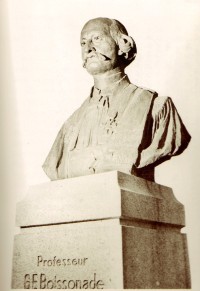The History of Hosei University Reflected in the Spirit of School Foundation
The history of Hosei University begins in 1880 (year 13 of the Meiji era) when the non-governmental lawyers Kanamaru Magane, Ito Osamu, and Satta Masakuni established the Tokyo Hogakusha (Tokyo School of Law) at 19 Kita Koga Machi, Surugadai, Tokyo. In 1880, a penal code and criminal procedure law which were forerunners of modern Japanese laws were introduced, and the birth of Tokyo School of Law was in response to the trends of the time which saw an upsurge in individual freedom movements and began the development of the modern legal system.
Since its establishment the Tokyo School of Law never been simply a center for law instruction, but has also featured a "daigensha", proxy speaker association (the original terminology for Japanese lawyers being "daigennin" or "proxy speaker") where "on the job" legal training was carried out, and has always been more of a "gakusha", learning association or society" which cultivates legal experts than simply a "school", and has always given great consideration to the establishment of freedom and the advancement of national society through its in-service training activities. It can thus be seen that the practical and career training spirit that the school practices today originated in and is simply a continuation of the practices from the time of the school's founding.
This "freedom and progress" oriented spirit of the school's foundation can be traced back to the spirit of French law. Satta Masakuni and the majority of the other's who were involved in the founding of the Tokyo School of Law were students of Dr. Gustave Emile Boissonade of the University of Paris, who had been invited by the Japanese Government as a legal advisor. Boissonade introduced the concept of "jus naturale", or natural law, to Japan and in addition to drawing up the civil code, penal code and criminal procedure, was known to have fostered a great number of lawyers. In 1881 (year 14 of the Meiji era) private "daigensha" proxy speaker associations were outlawed and the "daigenkyoku" proxy speaker department was closed and the law instruction department made independent and renamed Tokyo Hougakkou or Tokyo School of Law and Boissonade was appointed as the director of the school in 1883 (year 16 of the Meiji era). Then in 1889 (year 22 of the Meiji era) the school was merged with "Tokyo Futsu Gakko" or the Tokyo School of French Studies, which was established by the "Futsu Gakkai" or French academic society in 1886 (year 19 of the Meiji era), and renamed "Wafutsu Horitsu Gakko" or the Tokyo School of Japanese and French Law and Mitsukuri Rinsho, the translator who translated the French civil code and created the translations "kenri" (rights), "gimu" (obligation, duty, liability), and "minshu" (people's rights), was appointed as the head of the school.
In 1889 (year 32 of the Meiji era) Ume Kenjiro was appointed as head of the school and implemented diverse educational reforms which gave great consideration to general society which included not only the establishment of advanced courses for the recurrent education of graduates as well as English, German and French language "elective courses", but also the introduction of short term training systems for working off-campus students to study using school-issued texts, as well as an auditing student system and preferential student systems. These reforms bore great results and the school was renamed the Tokyo School of Japanese and French Law/Hosei University based upon the "Senmongakkourei" (Professional School Imperial Edict) in 1903 (year 36 of the Meiji era). The new school offered afternoon preparatory courses and evening university and professional courses as well as advanced research courses which were equivalent to modern day graduate school and Ume was appointed as the first president of the new school.
The school today still continues to rely upon the spirit of the educational reforms, whose purpose and concept is based on an "open education", which originated from the ingenuity and innovation of Ume.
Thereafter, the establishment of private universities became possible pursuant to the University Order in 1918 (year 7 of the Taisho era). As a result the school was again reformed into Hosei University in 1920 (year 9 of the Taisho era). This was the birth of the Hosei University with the same name and basic structure as today's school. The Faculty of Law and the Faculty of Economics were established first, and preparatory and professional courses were also offered. A new campus was built at 4 Fujimicho, Kojimachi Ward (the current location) in 1921 (year 10 of the Taisho era) and the school relocated to this new campus. In 1922 (year 11 of the Taisho era) a Literature Department and Philosophy Department were established in the Faculty of Law, and its name was changed to the Faculty of Law and Literature. During this time the instructor system was switched from a lecture-based instructor system to a full time instructor system and the class types were refocused from evening classes to afternoon classes and Hosei University began to take form as a standard university.
At present Hosei is a comprehensive university with 15 undergraduate faculties, a School of Correspondence Education, 14 graduate schools, 1 institute, and 2 professional schools.

A bust of Dr. Boissonade who made a great number of contributions to the school's educational system. Currently installed on the 26th floor "Sky Hall" of Boissonade Tower.

